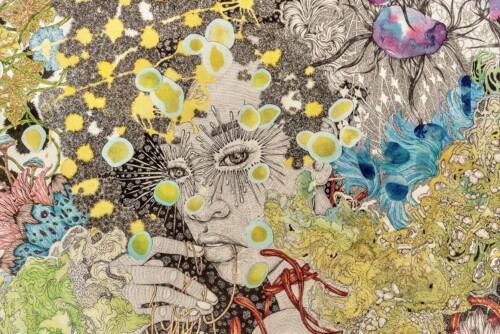In Princess Tam Tam, the character played by Baker is a foil to the white man’s desire for a white woman. Yet thanks to the autobiographical reference and transitivity at the core of desire, the film also—ironically—makes him a foil to what she embodies: the dancer’s talent.1 A spoof on French colonial films of the period, it offers a ceaseless kaleidoscopic array of “borrowings” from a European colonial bric-a-brac that thinly veils the traces of Baker’s earlier stage acts, her former “identity” as an African American.2 However, dual oppositional readings fail to account for the complexity of the references on which Baker consciously played. To reclaim her African-American heritage privileges her “original” national identity over the one she took on, as well as her gradual “belonging” to French culture. A polarized reading of La Bakaire that opposes, on the one hand the black female body as “subjected” to colonial oppression, the object of voyeuristic desire, and on the other hand, the black woman as an “agent” of transformation is too schematic. Baker’s singular combination of eroticism and sensuality, together with a talent for the comic and a foregrounding of the childlike, complicate any interpretation of her reception.
Moreover, the enigma of Woman—at the center of the fascination with Baker—is not to be easily deciphered. That enigma must be read alongside Joan Rivière’s groundbreaking analysis of womanliness as a “masquerade.”3 Baker, more than anybody, played on performing, acting, and disguise. In her Mémoires, she admits that this stems from a childhood habit: “I forgot to tell you that one of my earlier habits was to dress up to see what people would say” (M, 43). She also compared the screen to shadows, and its images to “the discolored light of dream” (M, 146), in a strangely faithful rewriting of Plato’s myth of the cave:
I suddenly wake up in the middle of the night. The shadows are all out there, those from my childhood, and those from books, and particularly those from my dreams. I get up. I tiptoe. I chase shadows that disappear, that fade under the electric light, in rooms, bathrooms, through closets, from step to step, in the staircases, under beds, in the corners of curtains. Nothing remains but the house lit up from top to bottom like a screen on which shadows go by. […] From that to the cinema, there is only one step. You will understand why I love—why I adore—the movies. They are the endless play of all shadows, be they sad or funny; they are dreams in black and white. At the movies, I have never seen colors as vivid as I like them. (M, 146)
Although edited and rewritten by journalist Marcel Sauvage, Mémoires relates childhood memories, placing Baker’s love for disguise at the origin of her artistic vocation.4 Her metaphor of the silver screen as dream material in black-and-white is also a clue to the reading of the film in relation to phantasm. The irreducible core of fascination that she exercised can be explained at least in part by the references to her autobiography that made up the intricacies of her elusive private script as she fashioned herself into a popular icon. It also finds its source in the complex relation that Baker embodied in relation to Africa, thanks to her African-American “identity.”5 This interrelation of elements from the personal (her life) with the public image (her celebrity)—the web of self-references, although difficult to unravel—is a clue to her power of attraction.
- My analysis runs counter to Phyllis Rose’s comment: “If in real life it all began with desire, in the film versions of her transformation, all traces of desire are erased. Neither Zou Zou nor Aouina, the heroine of Princesse Tam Tam, is responsible for her own change. Each is the passive object of the other’s activity.” Jazz Cleopatra: Josephine Baker in Her Time (New York: Vintage Books, 1989), p. 164. [↩]
- See Andy Fry’s reading of Baker’s performance in Offenbach’s La Créole in view of the changes made by the librettist to use the opera as a shrine for Baker’s talent: “Du jazz hot à La Créole: Josephine Baker sings Offenbach,” Cambridge Opera Journal 16: 1, 2004, 43-75. See also Olivia Lahs-Gonzales, Josephine Baker: Image and Icon (St Louis, Missouri: Reedy Press, 2006); Bennetta Jules-Rosette, Josephine Baker in Art and Life: The Icon and the Image (Champaign-Urbana: Illinois University Press, 2006). [↩]
- Rivière, Joan. “Womanliness as Masquerade.” The International Journal of Psychoanalysis 10 (1929) in Formation of Fantasy. Eds. Victor Burgin, James Donald, and Cora Kaplan (New York: Methuen, 1986), 35-44. [↩]
- Marcel Sauvage was a journalist and a writer who claims that he harbored some “affection” for the black world in the preface to Pierre Massoni’s Haïti, reine des Antilles (Paris: Nouvelles éditions latines, 1955), p. 8. He is the author of Les Secrets de l’Afrique noire (Paris: Grasset aventures, 1981). Only a close look at the manuscript, if available, might help assess what was Baker’s and what was Sauvage’s own import to what the readers are given here as Baker’s voice. One knows that her opinions on World War II were excised from the Mémoires and that she had a quarrel with Sauvage at one point in their collaboration. [↩]
- See Sieglinde Lemke, Primitivist Modernism: Black Culture and the Origins of Transatlantic Modernism (New York: Oxford University Press, 1998): “The plot is a metaphor for Baker’s own story; it echoes the revivification trope underlying the dynamics of primitivism” (p. 108). [↩]




